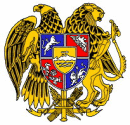- Republik Armenien
- Lage
- Süd-westliches Asien (Kleinkaukasus) zwischen der Türkei im Westen, Georgien im Norden, Aserbaidschan im Osten (und Westen: aserbaidschanische Exklave Nachitschewan) und dem Iran im Süden. Armenien erhebt Anspruch auf das vollständig von Aserbaidschan umschlossene, armenisch besiedelte Gebiet Berg-Karabach.
- Fläche
- gesamt: 29 800 qkm
- Land
- 28 400 qkm
- Wasser
- 1 400 qkm
- Landesgrenzen
- gesamt: 1 254 km
- Grenzstaaten
- Aserbaidschan Kernland 566 km, Aserbaidschan Exklave Nachitschewan 221 km, Georgien 164 km, Iran 35 km, Turkei 268 km; keine Küste
|
Daten des Statistischen Bundesamtes |
|||
| Bevölkerung | 3,8 | Mill. | 2001 |
| Fläche | 29800 | qkm | 2001 |
| Bevölkerungsdichte | 127 | Einw. je qkm | 2001 |
| Arbeitslosenquote | n.v. | ||
| Bruttoinlandsprodukt (BIP) | 1914 | Mill.US-$ | 2000 |
| Jährliches BIP-Wachstum (real) | 6,0 | % | 2000 |
| BIP je Einwohner (real) | 976 | US-$ | 2000 |
| Inflationsrate | -0,8 | % | 2000 |
| Importe | 882 | Mill.US-$ | 2000 |
| Exporte | 294 | Mill.US-$ | 2000 |
| Saldo der Im- und Exporte | -588 | Mill.US-$ | 2000 |
| PKW-Dichte | n.v. | ||
| Personal-Computer | 8 | je 1000 Einw. | 2001 |
- Bevölkerungsdichte
- 127 Menschen je qkm
- Hauptstadt
- Eriwan (Jerewan), ca. 1 300 000 EW
- Städte
- Yerevan 1 200 000, Gyumri (121 000 EW), Vanadzor (74 000 EW) und Abovian (54 000 EW).
- Staatsform
- Präsidialrepublik seit 1991, Verfassung seit Juli 1995 in Kraft. Ein-Kammer-Parlament mit 131 Sitzen. Wahl alle 4 Jahre. Direktwahl des Staatsoberhauptes alle 5 Jahre. Der Staatspräsident verfügt über weitgehende Exekutivvollmachten. Die Regierungsgeschäfte werden vom Ministerrat mit dem Ministerpräsidenten an der Spitze geführt.
- Verwaltungsstruktur
- 10 Distrikte, 1 Stadt (Jerewan)
- Klima
- Kontinentales Hochlandklima mit großen Temperaturgegensätzen und geringem Niederschlag. In Jerewan beträgt die durchschnittliche Temperatur 11,6 °C. Extremtemperaturen sind 47 °C und -26 °C.
- Landschaft
- Armenien ist ein Gebirgsland und wird fast vollständig von den Ausläufern des Kleinen Kaukasus eingenommen. Der Großteil des Landes liegt in 1.000 bis 2.500 m ü.d.M.. Im Norden und Osten liegen die über 3.000 m hohen Gebirgsketten des Kleinen Kaukasus. Größter See Armeniens ist der 1.900 m ü.d.M. liegende Sewansee.



